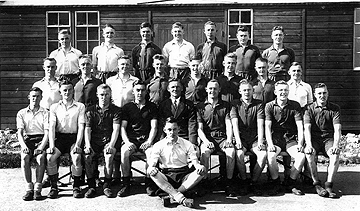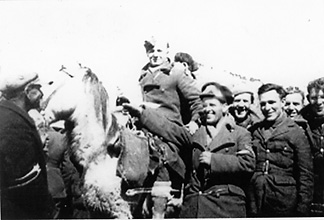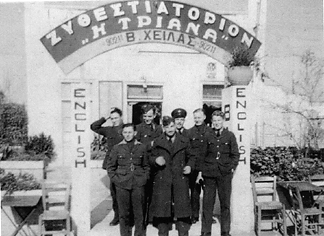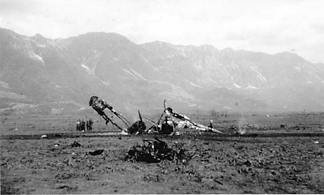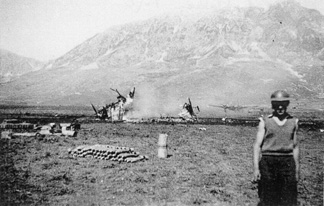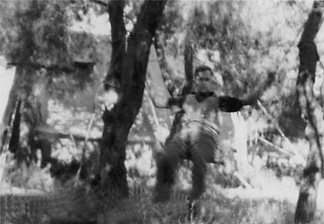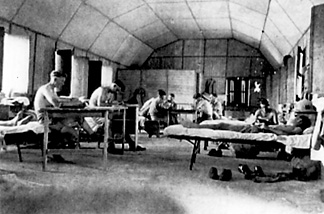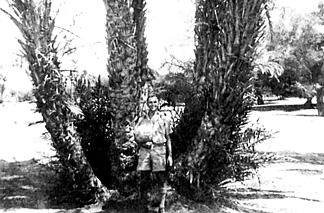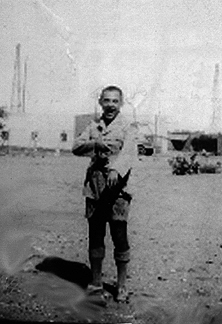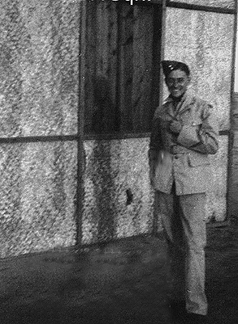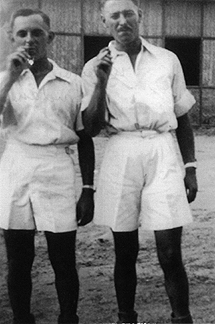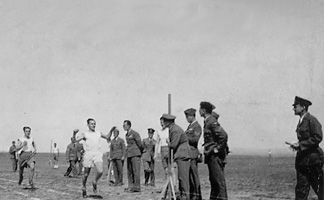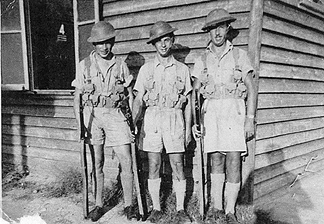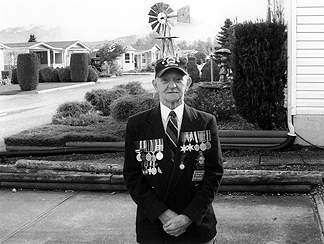 |
 |
||||||||||||||||
|
Corporal Cecil Norman “Titch” Hansford 549069 RAF 1920—2015 Cecil, otherwise “Taffy” or at 5’ 3” rather inevitably “Titch”, as a Fitter II (Airframe) in 211 Squadron nearly found himself stranded in both Greece and in Crete.
Born on 28 August 1920, the young Hansford was one of many who joined the RAF in the later years of uncertain peace. At Cardington by February 1938, he went on to serve in various Metropolitan units including stints with 24 Squadron and with the Fleet Air Arm before leaving for the Middle East in mid-November 1940.
That’s young Cecil, last on the right, middle row. Joining 211 Squadron in Greece on the 29th of December 1940, he was to avoid capture in Athens and on Crete by the skin of his teeth. “Titch” returned to his Squadron in Palestine and went with them to Wadi Gazouza. Falling ill there, he was hospitalised in Khartoum and hence missed the 72 OTU draft back into 211 Squadron in late December 1941. He went on to a range of postings, often in that valued field back-up organisation, the Maintenance Units. In late 1941 he was posted to 102 MU but ended up with 111 MU by 3 January 1942, at Tura, 14 miles south of Cairo. The site, among the limestone quarries and caves of the Pharaohs, was a major radio and vehicle parts facility which later undertook aircraft, engine and signals repairs and general engineering. Moving to RAF Station Gaza, he spent over 6 months of 1942 back in Palestine before returning to 111 MU ‘A’ echelon at Tura. By July 1943 he was again in Palestine, with 74 OTU at Aquir. Eventually he did make it to 102 MU, in April 1944. By then they were based at Amiriya, operating as a Repairable Equipment Depot. By 1945 he was with 4024 Servicing Echelon. In 1946 he returned to the United Kingdom and re-enlisted in the regular RAF and by 1947 had been posted overseas again. Cecil remained in RAF service until 1948. Finding himself in India at Partition, he declined to transfer to either the Pakistan or the Indian Air Force and was shortly thereafter repatriated to the UK to leave the RAF a Corporal Fitter IIA. Cecil’s technical skills carried him far in the world of aircraft engineering, first settling in Canada and work with de Havilland Canada and Canadair among others. With his close family in Australia, Cecil returned in the late 1950s both in Sydney and for some years in Melbourne, working at the Commonwealth Aircraft Corporation factory at Fisherman’s Bend. On returning to Canada, he remained in the aerospace industry, with McDonnell-Douglas in Ontario and others. Cecil and his wife Audrey later took up residence in British Columbia. Over the years, his sense of adventure still called, on one occasion making the car trip far across Canada to visit close friends 2800 miles away in Ontario. It was Cecil’s mate Arthur Gentle who found the 211 Squadron site. Between the three of us we enjoyed a correspondence both plain and email over a good many years, by which means, though thousands of kilometres apart, we may share Cecil’s memories and photographs. Adventures in Greece “Well, I served in Tatoi (Menidi) with 211 Squadron and was on a night pass to Athens. Its sort of a complicated story but when I got back the Squadron had gone and left me!! I was in a proper bind as I had no money, no food, no accommodation. After smoking one or two of those Papastratus cigs I thought about the pickle I was in and then I remembered that there was another outfit a few miles from Menidi. I am not sure of this but they were long nose Blenheims that may have been 84 Squadron [Jefford and other sources show both 84 Squadron and 113 Squadron with Mark IVs and stationed at least in part at Menidi. Elevsis was 10 miles away near the coast]. Anyway I had always been a great runner and I ran all the way to where I guessed they would be. I was in luck as there was one aircraft running up and I got there just in time to get a lift to Heraklion only if I volunteered to be the top turret Air Gunner. What other chance did I have, so off we went and we were fired upon by the Navy because the Pilot forgot to fire his Very pistol (colour of the day: green). We landed at Heraklion and I was told by the Pilot that was as far as he could take me. So now I am on Crete with no support at all. I am roaming around the Island and I get picked up by an Army Sergeant who said I was to go down to the water’s edge and help unload gasoline. After being there for some time we got a raid by about 8 Stukas who really plastered the area. I went underground and for quite a while I stayed there. When the bombing stopped I came out and there was no one around, just smoke and fires. I continued to roam the Island and found quite a bit of food and arms around. I picked up two Smith and Wesson revolvers and a rifle and two bandoleers of .303in ammo. I must have looked like a guerilla. I don’t know how many days I was on my own, only that I slept under any good cover I could find. After a while I found myself down at a place called Suda Bay, and right there was moored a Flying Boat with the RAF roundels. I just couldn’t believe it, but my good luck just about left me as an officer of the RAF came by and asked me who I was. I told him my number rank and name and he told me to get lost and take my chance on the Island. After some considerable chit chat he got up and started to walk towards the aircraft. He half turned and said “I don't know you and I haven’t seen you, but if you can get on this aircraft I don’t know how you did it”. And that’s how I escaped capture by the Germans on Crete. I stole onto the aircraft about 4am in the morning and got right down in the tail end. I gave myself up at ? when we landed [Possibly Alexandria or possibly Aboukir. 230 Squadron had detachments at both and had landed many evacuees at Alex]. I was interned at ? for about 3 weeks with hundreds of other guys from all different services. I eventually got posted to Palestine.” Photographs In Greece 1941
A mixed bag of Greeks and RAF servicemen, apparently. Cecil subsequently identified this shot as at Agrinion in 1941, with McBride mounted on the donkey, then (left to right) Cpl J Townsend, WA Lee (possibly Fitter IIA 622386 AC1 Lee W later of 72 OTU), J Owens (possibly Fitter IIE 572463 LAC Owens JL later of 72 OTU), Robson and B Crutchley (possibly Fitter IIA 572767 LAC Crutchley BR later of 72 OTU), all of whom signed the shot along with LAC Dave Ray—who is obscured behind the villager, left. A Flight Mechanic (Airframe) and close friend of Cecil’s in Greece and The Sudan, Ray was posted to the Far East with 211 Squadron in January 1942. Taken captive at the fall of Java, LAC Derrick David Ray 546670 died a prisoner of war in October 1944 on Ambon.
Left to right, rear: Owens, Robson, Arthur Leroy, McBride. In the front row, Cecil on the left, Brett, Crutchley. Outside The Triana, restaurant of one B Xeilas. The taverna’s telefono appealed to the lads: 90211.
Cecil was with ‘C’ Flight, down by the river, to the right of these images. To the left of the smoking wreckage, Paramythia lies on the lower slopes of Mount Koryllas. See also CFR Clark, RJ Dudman and HF Squire.
Cecil relaxing on his day off, on a swing slung between olive trees—his tent just visible to the rear. In The Sudan 1941—1942
Cecil’s place in the airmen’s billets is in the right rear corner, marked with a white x. During the Squadron’s sojourn in Sudan, he contracted enteritis and ended up in hospital in Khartoum. By the time he had recovered, the 211s had been extracted from 72 OTU bound for the Far East, so Cecil doesn’t appear on the 72 OTU Movement Order of 19 December 1941 and its roll of airmen ordered to Helwan to re-form the Squadron.
Recovered from his illness, Cecil takes in the local scenery - a shady spot among the date palms.
Cecil celebrates. The Good Conduct Badge, an inverted chevron or “tape”, could be awarded after three years service with consistent VGs in the airman’s Conduct column. Second and third badges fell due at eight and thirteen years service. Each badge entitled an airman to 3d per day good conduct pay.
In sporting whites, celebrating. In Palestine 1942—1943
Quite an athlete in his day, here Cecil is in good form, breasting the finishing tape in a mile race at Gaza in Palestine, cMarch 1942. The runner-up in hot pursuit is the Greek mile champion from a local Greek unit—Cecil had been posted to RAF Gaza early that month. Among the figures at the finish line is one Sgt Burroughs.
Yorky, Cecil, and Arthur Leroy outside their billet at Gaza, about to start a Commando course. After the struggle
With his campaign medals (1939—45 Star, Africa Star and clasp, Defence Medal and War Medal) and a considerable collection of other commemorative medallions. After this photograph was taken, Cecil, like a number of the Middle East 211s, had his service acknowledged by the Greek government with the award of the Commemorative Medallion of the Hellenic Republic. Some of his favourite war-service yarns were recorded by the Chilliwack Times in September 2014. Cecil kept up an active interest in Blenheim and 211 Squadron matters as the years passed. On visiting the United Kingdom in the Summer of 2012, in company with Ian Carter of the Blenheim Society he was able to visit the RAF Museum Duxford and see the Bristol Blenheim restoration work, thanks to John Smith of ARCo. The rebuilt aircraft at long last took to the sky once more in late November 2014. A widower in his 95th year, Cecil Norman Hansford departed this life on 1 April 2015 in British Columbia. Farewell, Taffy. Sources 72 OTU Operations Record Book TNA AIR 29/686 (Movement Order & Roll 19 December 1941) Bristol Blenheim: Journal of the Blenheim Society Issue 75 March 2013
www.211squadron.org © D Clark & others 1998—2025 |
||||||||||||||||
